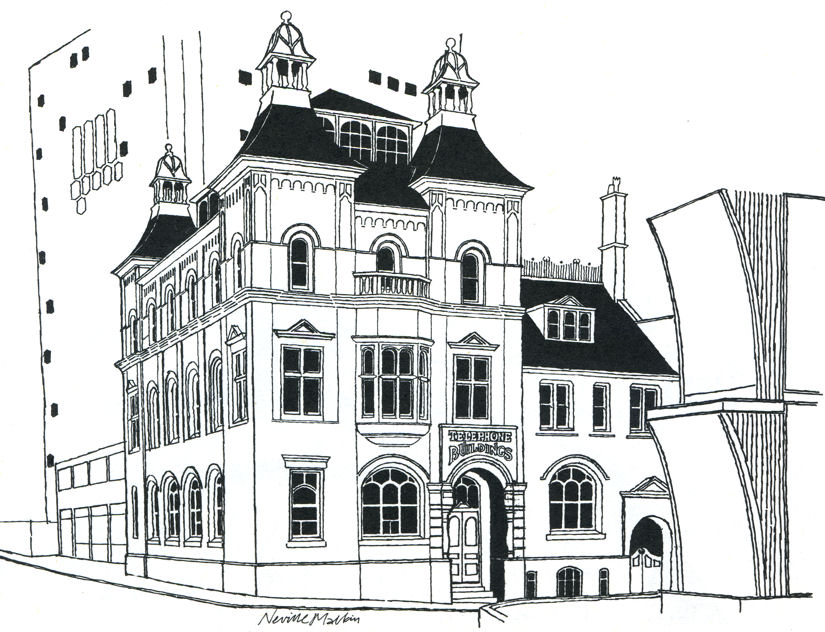|
|
|
![]() back to "The Grand Tour" index
back to "The Grand Tour" index
Neville Malkin's "Grand Tour" of the Potteries
buildings of Hanley
![]()
![]()
![]()
next: St. John's Church, Hanley
previous: Hanley Railway
Station
contents: index of buildings in Hanley
|
No 64 - Telephone Buildings, Hanley
|

Telephone Buildings, Hanley
pen drawing by Neville Malkin - July
1974

Contrast between the old
and the modern telephone exchange buildings
photo: June 2008
|
"This
Renaissance-styled building, an interesting exercise in bricks and
mortar, is the Telephone Buildings in Hanley. The four-storey
building, which has stood unaltered since its opening in early 1900,
appears to have little future, especially as the purpose-built
concrete construction to its rear nears completion.
Until 1861 the only means of sending a "wire" was from Stoke Railway Station. In 1862 the United Kingdom Electrical Telegraph Company succeeded in obtaining permission from Parliament to lay lines to all parts of the U.K., and in that same year Manchester was connected to Harecastle. By November 1862 a line was brought from Stoke to Hanley Railway Station; this office then moved to premises in Fountain Square. By 1863 telegraph offices had been opened throughout the Potteries, with the exclusion of Fenton. During the latter part of the 19th century the popularity of the telephone grew. In 1890, there were 211 subscribers in the area, and all the main police stations had been connected. The telephone was still a great novelty, and on a Sunday in April, 1891, the National Telephone Company invited people to their premises in Cheapside to listen to a church service from Birmingham; 40 receivers were used for the occasion. As the system developed, so did the need for such a means of communication. By 1899, the Company, recognising its essential role in the everyday life of the Potteries, decided to build a new and much larger Exchange. For this purpose it acquired approximately 600 square yards at the corner of Marsh Street and Mill Street (Trinity Street). The Company's directory of 1904-5 covered all the country, and the number of subscribers in the Potteries and district was about 2,200. Continued improvements saw the introduction of the 999 emergency service, inaugurated in the City by the Lord Mayor, Mr. Peter Williams, from his parlour in Stoke Town Hall, during his term of office in 1945-6." |

Central segmentally arched
window with mullioned
and transomed oriel bay over

Former telephone exchange and offices. Circa 1900. Brick and terracotta with plain tiled roof. Eclectic style, with main block of 3 storeys, and 3 narrow bays with flanking towers, all vertical spaces elongated. Doorway to right with terracotta scroll and lettering over given name, "Telephone Buildings". Ornate 6-panelled door with stained glass to overlight in segmentally pedimented head carried on bulbous recessed columns with rusticated surrounds and high bases. Central segmentally arched window with mullioned and transomed oriel bay over. Balustraded parapet above and 3 round-arched upper windows. Outer first-floor windows, of 2 mullioned and transomed lights, have shallow pedimented heads with egg-and-dart decoration. Moulded terracotta architrave to lower left hand window. Moulded string course and eaves band. Towers have decorative terracotta panels and corbel table and bell-cast tiled roofs and leaded turrets carried on bulbous balusters. Central dormer in roof of 3-lights with pediment. Wrought-iron balustrading forms ridge cresting. Lower block adjoins to right, 2 bays, with coped gable and segmentally arched 3-light window. Doorway to right with terracotta moulding and pediment over.
|
![]()
![]()
![]()
next: St. John's Church, Hanley
previous: Hanley Railway
Station
contents: index of buildings in Hanley
back to "The Grand Tour" index